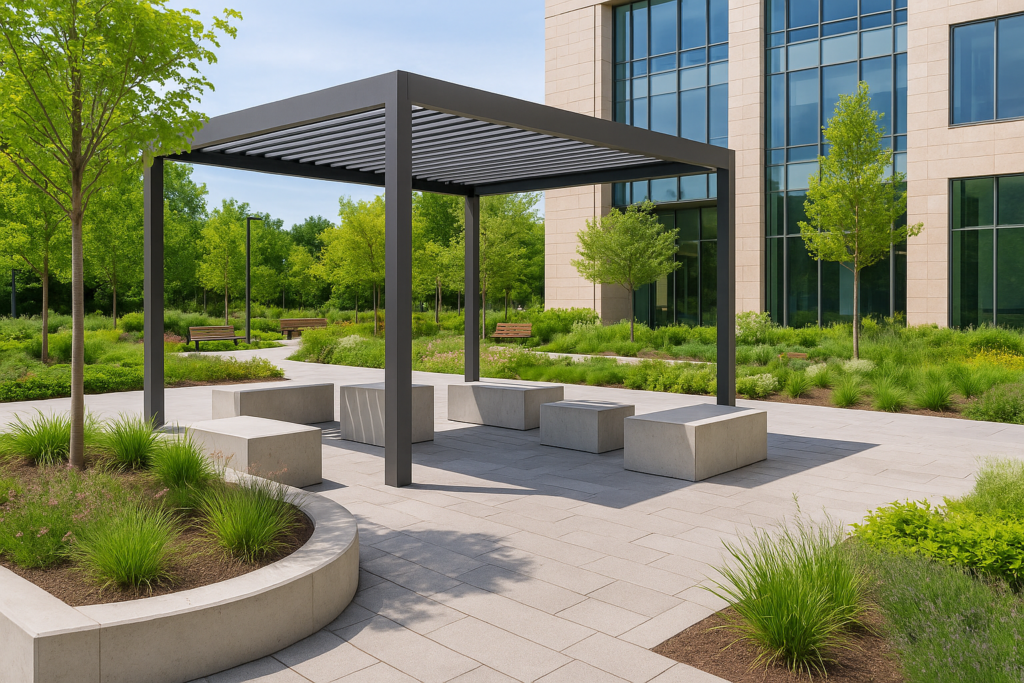When architects and designers define landscape within the realm of modern architecture, they go far beyond planting trees and placing benches. Instead, landscape design becomes an integral part of how people experience space, whether in residential homes, public gardens, or large-scale urban developments. Modern architecture embraces landscapes as functional, aesthetic, and sustainable elements that not only enhance beauty but also address ecological, social, and cultural needs.
In this article, we’ll explore how contemporary practices blend architecture with landscape, how technology and materials shape outdoor spaces, and why sustainability sits at the heart of these designs. We’ll also examine specific examples and tools that bring these concepts to life.
The Shift Toward Integrated Landscape Architecture
For centuries, architecture and landscape were treated as separate disciplines—one focused on buildings and the other on outdoor aesthetics. Modern practice now unites these into seamless environments. The concept is to design structures and landscapes that complement each other in form, function, and purpose.
For example, residential projects now extend living rooms into patios with retractable glass walls, while corporate campuses use green roofs and courtyards to connect workers with nature. Architects today recognize that outdoor spaces are just as essential as indoor ones in shaping how we live, work, and relax.
Core Concepts That Define Landscape in Modern Design
To define landscape in modern architecture, designers rely on a combination of timeless principles and innovative approaches. Some of the most important include:
1. Flow and Connectivity
Modern landscapes emphasize smooth transitions between indoors and outdoors. As highlighted in Architects Define Landscape Flow in Residential Design, the placement of patios, decks, and gardens encourages movement and interaction while reinforcing harmony between natural and built forms.
2. Sustainability and Resilience
Sustainability is not an optional feature but a requirement. Water-efficient irrigation systems, solar-integrated pergolas, and recycled building materials form the backbone of eco-conscious projects. By linking ecological responsibility with aesthetic appeal, architects create landscapes that conserve resources and withstand environmental challenges.
3. Public Engagement
Public spaces, such as parks and botanical gardens, are designed with artistry in mind. As explored in Experts Define Landscape Artistry in Public Gardens, these landscapes use plant palettes, water features, and walking paths to foster cultural connection, relaxation, and community pride.
4. Large-Scale Development Roles
Contractors also play a key role in shaping how landscapes function in major projects. In Contractors Define Landscape Roles in Large Development, emphasis is placed on balancing infrastructure demands with environmental and social considerations. These projects demonstrate how landscape architecture impacts city planning and economic growth.
Materials and Tools That Bring Ideas to Life
Selecting the right materials and tools is crucial in translating design concepts into reality. Modern architecture demands solutions that combine durability with aesthetics.
Material Handling in Construction
Projects often depend on efficient material handling systems to move heavy building and landscaping elements like stone, glass, and steel. Advanced lifting tools reduce labor time, minimize risks, and ensure precision during installations.
The Role of Gantry Cranes
On larger construction sites, a Gantry Crane provides the muscle required to maneuver massive structural and landscape elements. Portable gantry cranes are particularly valuable in modern landscaping projects that require flexibility across multiple zones of development.
Sustainable Glass Solutions
Glazing has become a critical feature in modern designs. Beyond aesthetics, insulated glass offers real environmental value. For instance, Insulating Glass Unit Benefits for Energy Savings show how advanced glass technology contributes to reduced energy consumption while maintaining comfort and elegance.
Innovations Driving Modern Landscape Architecture
Technology and creative design are reshaping how landscapes are planned and experienced. Notable innovations include:
- Automated Roof Systems: Structures like louvered pergolas provide adjustable shading, enabling homeowners to customize their outdoor comfort.
- Smart Irrigation Systems: Internet-enabled irrigation conserves water by adjusting schedules based on weather forecasts and soil moisture levels.
- Modular Gardens: Vertical gardens and movable planting systems add greenery to areas previously considered unusable, such as building facades and rooftops.
These innovations not only enhance usability but also reinforce the importance of landscapes as adaptable, multifunctional environments.
The Role of Aesthetics in Outdoor Spaces
Landscape design isn’t just about utility; it’s about artistry and emotion. For example, Studios Define Landscape Innovation for Outdoor Living explores how creative studios use design concepts to make outdoor areas extensions of modern living. Similarly, Studios Define Landscape Aesthetics for Outdoor Spaces demonstrates how balance, rhythm, and color shape both private and public environments.
When these aesthetic principles are woven into functionality, outdoor spaces become memorable, whether it’s a tranquil garden retreat or a bustling public square.
Landscape as a Reflection of Culture and Community
Every project has a cultural dimension. Public plazas, urban gardens, and green corridors reflect community values and aspirations. Landscapes designed for cultural significance may include sculptures, native plantings, or pathways that celebrate local heritage. By defining landscape in this way, architects and planners ensure their work resonates on a deeper social level.
Final Thoughts
To define landscape in modern architecture is to go beyond design—it’s about creating meaningful, functional, and sustainable environments. Whether in residential homes, public gardens, or urban developments, landscapes are now recognized as essential to well-being, culture, and ecological responsibility.
From the tools of material handling and the use of a Gantry Crane, to the artistry explored in Experts Define Landscape Artistry in Public Gardens, modern practice shows that landscape is not just an afterthought but a driving force in architectural innovation. With sustainability at its core and technology enhancing its reach, landscape architecture is set to define the future of how we live and interact with our surroundings.

